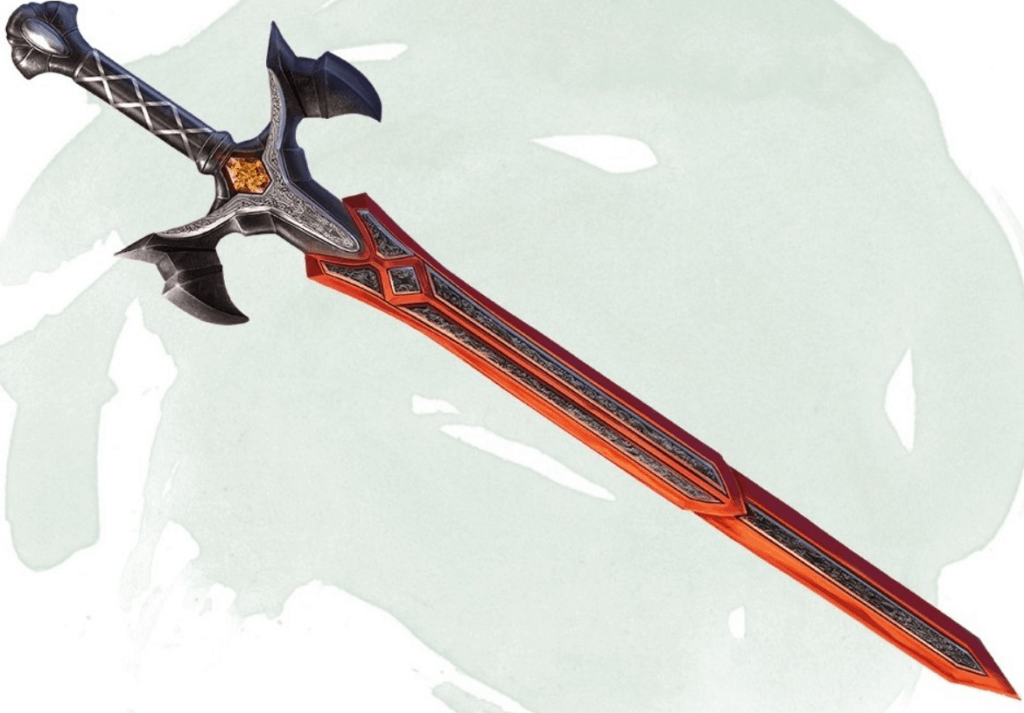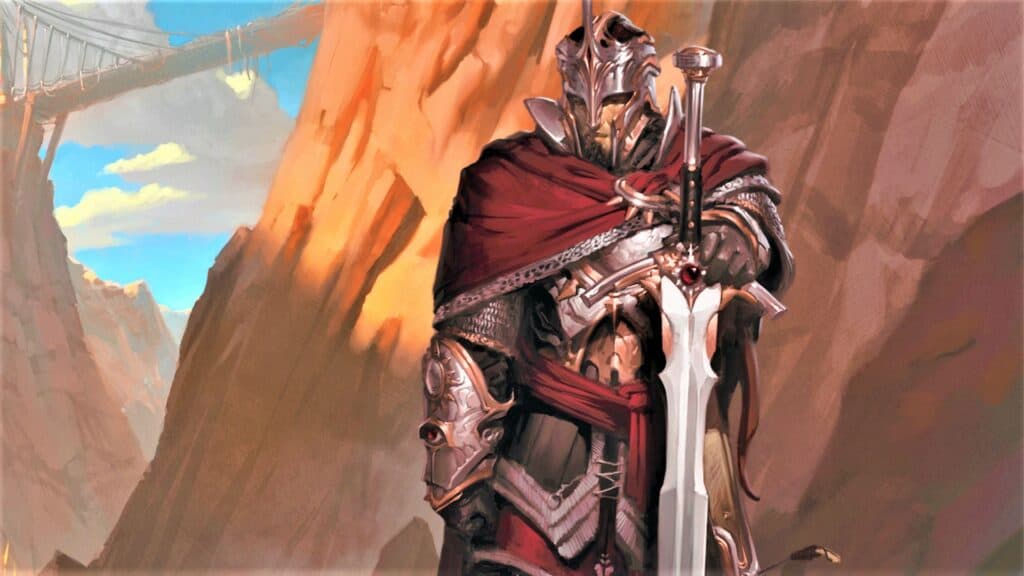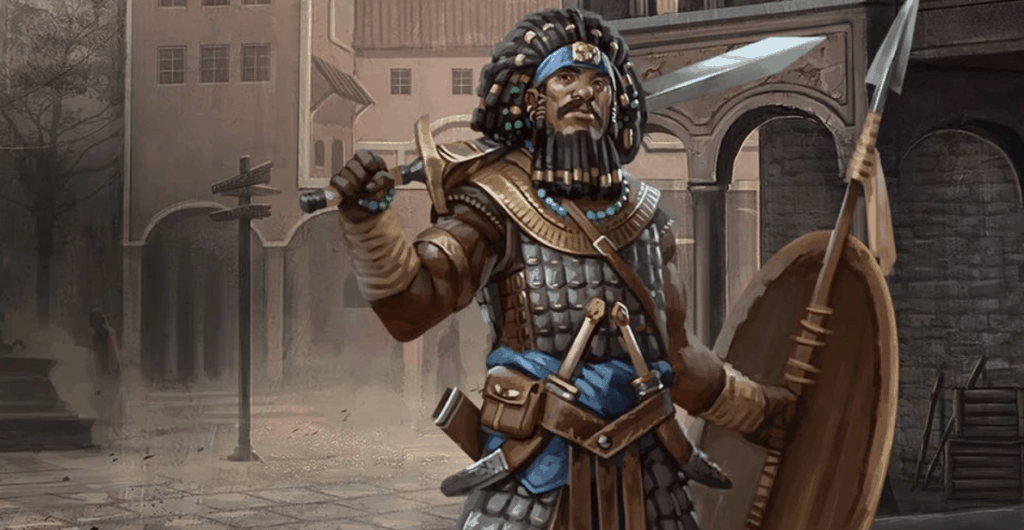There’s nothing like charging a barbarian into battle, hopped up on rage, and swinging a greatsword larger than himself at the nearest enemy. And there’s nothing more terrifying than seeing your enemy do the same thing. Greatswords are like bread and butter for certain classes and characters in a D&D game, and they are that way for a reason.
These swords pack a lot of stopping power into their hits, and if someone like an orc or a firbolg is wielding a greatsword like it is nothing, you know that they have some strength within them. Here’s all you need to know about this awe-inspiring and dragon-stopping weapon!
What Is A Greatsword?
Greatsword
- Type: melee weapon (martial, sword)
- Category: Items
- Damage: 2d6
- Damage Type: Slashing
- Item Rarity: Standard
- Properties: Heavy, Two-Handed
- Weight: 6
We are going to break down these stats from the Player’s Handbook. It does 2d6 slashing damage, so a max of 12 normal damage before any modifiers. It’s a standard item, though not common, and comes with two properties: Heavy and Two-handed
Heavy means that creatures with the small and tiny size types (Gnomes, Kobolds, Goblins) could not wield greatswords and if they did their attack rolls had disadvantages. Having a heavy weapon is also a requirement for some feats, including the Great Weapon Master feat.
Two-handed means that the weapon requires two hands to wield. As epic as it is, picturing one barbarian with a greatsword in one hand and a massive shield in the other, that just doesn’t work in 5e. You need two hands free to wield this D&D weapon.
A greatsword is one of the hardest hitting weapons in the game, especially since you can synergize it with various feats to make sure that the damage output goes even higher!
Who Can Use A Greatsword?
With a weight of 6, it does require some muscle to be able to use this sword effectively. Otherwise, you just need proficiency in martial weapons, which the character sheet will say that you have. Fighters and Barbarians are the most likely to wield greatswords. Paladins can wield two-handed weapons but are often best paired with a shield for protection instead.
The Best Greatsword Builds
Here are some of the best feats and abilities that will synergize well with the use of a greatsword.
The first one is Savage Attacker. As per the Player’s Handbook: Once per turn when you roll damage for a melee weapon attack, you can reroll the weapon’s damage dice and use either total. This feat shines if you end up rolling low on damage, as when you reroll you can pick either option instead of being forced to take the second result or the lowest result.
For critical hits, it gets even crazier, as if you didn’t reroll your damage dice on a normal attack, you can use the feat to reroll a crit if you are disappointed in the roll.
Next, if you are playing as an orc or half-orc barbarian, you can take the frenzy from the Path Of The Berserker and use this ability: Starting when you choose this path at 3rd Level, you can go into a Frenzy when you rage. If you do so, for the duration of your rage you can make a single melee weapon attack as a bonus action on each of your turns after this one. When your rage ends, you suffer one level of exhaustion (as described in Conditions).
This means that you can add an extra attack as your bonus action while you are frenzied, and that means an extra 2d6 +modifiers of damage every turn. Perfect for greatsword users.
Fighters can also get in on the action with the Champion archetype at 3rd level, which allows them to crit at a roll of 19 or 20 rather than just 20. More crits equal more damage, and you can easily pair that with other feats such as Great Weapon Master which has these effects:
On your turn, when you score a critical hit with a melee weapon or reduce a creature to 0 hit points with one, you can make one melee weapon attack as a bonus action. Before you make a melee attack with a heavy weapon that you are proficient with, you can choose to take a -5 penalty to the attack roll. If the attack hits, you add +10 to the attack’s damage.
We could go on, but you are probably seeing a theme here. Any feats or abilities for a barbarian or fighter that will either increase the damage you do with your greatsword or will give you more opportunities to do that damage is something you need to snatch up right away. Especially if you want to min-max it.
Where Can You Get A Greatsword?
Greatswords are a standard item in the game, meaning that they are pretty common and most people use them. So if you don’t get the selection of a martial weapon in your adventurer kit or background, then you can probably find one at the nearest town that deals in weapons and armor. It does cost 50 GP, but you’ll probably get that amount of gold in loot from your first adventure, if not even more gold from loot and sold treasure.
So buying a greatsword isn’t outside the realm of possibility for an adventurer who doesn’t have one. You also might be able to loot one off of a bandit or other humanoid foe. After all, nothing binds you faster to a weapon than seeing all the damage it can do first hand and being on the receiving end! If it doesn’t kill you, you might as well try to get your hands on it, because the previous owner doesn’t need it anymore!
Can I Get A Magical Greatsword?
Much like every other item in D&D, the greatswords have magical variants. According to the DM, some worlds and adventures are filled to the brim with magical items, while others are pretty low magic and the magical items are very rare. You can sometimes purchase these weapons from vendors for a pretty heavy amount of gold, mostly focusing on the +1 and +2 variants of the weapon. These magical variants are pretty uncommon, but not rare, so you might find them in the hands of a powerful foe or in the collection of a wealthy merchant.
Other types of magical greatswords can have various effects, such as the holy greatsword Balmung, or the DragonSlayer Sword. Of course, clever DM’s can easily create their own homebrewed or altered magical weapons to give you even more greatsword options, and these weapons could be part of an epic quest or as a reward for a fierce battle against a tough foe.
Magical greatswords do exist, and whether they give you an extra modifier to damage or provide some other active effect, you should certainly try to get your hands on them!
Greatsword Or Sword And Board?
This might be a question for a paladin, but it can also apply to anyone who feels like their natural AC just isn’t cutting it, and that those extra two points provided by a shield could be very useful. It’s a choice that you can make based on role-playing or based on stats, but either way, it is a choice.
It comes down to attack vs defense. Having a shield and those extra two points of AC is vital during the early game where even a strike from a goblin will lay the toughest character of the party low, but becomes less so once you have some decent armor and a pool of health to take a few hits. Now, sure a shield might help you last longer in a fight, but the faster you can slay your enemies the faster you can make sure that your health stays intact.
Typically, for a barbarian and even a fighter, if you can take advantage of your armor and any bonuses that increase your survivability, then the damage boost from a two-handed weapon will outshine the extra AC from the shield. A Paladin is able to use the shield a lot better than a two-handed weapon, mostly because of the shield master feat.
This feat allows a paladin to shove an enemy with his shield as a bonus action, and if the blow succeeds the enemy is knocked prone. This makes the subsequent two melee attacks that a Paladin can do have an advantage, and if they score a crit on a prone enemy then they can smite away with all those damage dice!
So for Paladins, a shield build will have the opportunity to do just as much damage as a two-handed build, if you design it that way of course. Some builds do require shields as they can support tanky builds, and various shields have special effects or even enhancements that can make them useful in combat.
So it’s best to consider all your options as you go through the game. You really aren’t locked into a specific weapon or fighting style until you start picking feats that can improve one over the other. You don’t want to take feats that will improve your greatsword skills and then suddenly swap over to sword and shield for the next three levels because you lose all those benefits.
Greatsword 5e FAQ
Question: Should I Plan Ahead or Wing it?
Answer: With all this talk about builds and feats to maximize your greatsword damage, you might get overwhelmed and figure that you need to have your character’s path lined up in stone. While some players do like to min-max and figure out what will do the most damage, you can roleplay or wing it as the game goes on.
Maybe your character picks a feat for roleplay reasons or because it fits their character, even if it isn’t the most optimized. D&D isn’t like a video game where you have the risk of becoming under-leveled, as the DM will tailor encounters to your skillset, or give your party another way to handle the encounter.
So if you pick the greatsword or another two-handed weapon as your main, know that you aren’t locked into any path as you explore what your weapon can do. Plus, if you do feel locked into your character or aren’t having fun, you can always talk to your DM and they might be able to soothe your concerns and help you figure out what combat style you do like.
Question: How Does My Character Use A Greatsword Effectively?
Answer: While on paper it seems as though greatswords are the same as any other bladed weapon in 5e, in history, they were often used for area denial. These weren’t weapons you could have a fast-paced duel with, and instead, soldiers would use them for long, slow, and wide swings to deny opponents the ability to get close. These swords can hew and cleave if you’ve got the right amount of muscle behind it, and are perfect at fighting several warriors at once.
Your character can use these greatswords the same way, cleaving through several enemies with the cleave rule or the great weapon master feat. If you can focus on cutting down or damaging several enemies at a time with long swings, then that is the most effective use of a greatsword.
Question: How Strong Does My Character Need To Be To Lift A Greatsword?
Answer: Surprisingly enough, there’s no strength required to lift a greatsword in 5e. As long as you are not a tiny or small creature you can wield a greatsword with no trouble and no penalty. You just need to be proficient with martial weapons and you should be fine.
Now, you should have a high-strength mod, because you don’t want to be penalized and have to add a negative modifier to your attack and damage rolls. However, the high strength only applies to attack rolls and damage, not to your eligibility to wield the weapon.
- DnD Demons Guide: What Are Demons in 5e? - September 18, 2021
- Detect Thoughts 5e Guide: When, Why and How to Use It - September 9, 2021
- The Ultimate DnD Toll the Dead 5e Guide - September 9, 2021





